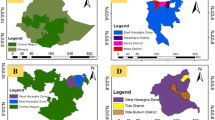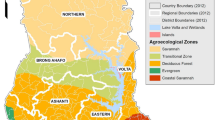Abstract
Many individuals are not only food insecure but chronically exposed to high levels of mycotoxins through their diets in many developing countries. Seventy composite samples of stored maize grains were collected from farmers’ storage structures in five agro-ecological zones (AEZs) of Nigeria where maize is predominantly produced between August 2011 and February 2012. The grains were analysed for mycotoxin contamination with the liquid chromatography tandem mass spectrometry method and mycotoxin occurrence maps constructed from the database of the distribution of the toxins. A risk assessment was also carried out in order to provide information on the extent of human exposure to the toxins. Twelve regulated mycotoxins with negative economic and public health consequences were detected in the maize grains across the AEZs at concentrations exceeding the maximum allowable limits including AFM1 that was detected for the first time in Nigerian maize. There is a high risk of contamination of the stored grains by Nigerian consumers especially in the Derived and Southern Guinea Savannas, resulting in a national burden of between 126.85 and 38,682.29 DALYs. Intervention strategies are therefore needed across the AEZs to ensure that safe and wholesome foods are made available to the populace.


Similar content being viewed by others
References
Conway GM, Toenniessen G (2003) Agriculture: science for African food security. AAS 299:1187–1188
Bankole SA, Adebanjo A (2003) Mycotoxins in food in West Africa: current situation and possibilities of controlling it. Afr J Biotech 2:254–263
Bhat RV, Vashanti S (1999) Occurrence of aflatoxins and its economic impact on human nutrition and animal feed. New Reg Agric Devel 23:50–56
Li Y, Wu F (2010) Global burden of aflatoxin-induced hepatocellular carcinoma: a risk assessment. Environ Health Perspect 118:818–824
Economic Community of West African States (2013) Concept note on aflatoxins. Regional conference on aflatoxin challenge in West African States. Accra, Ghana. 18–20 Nov 2013
International Agency for Research on Cancer (2002) Some traditional herbal medicines, some mycotoxins, naphthalene and styrene. IARC Monogr Eval Carcinog Risks Humans 82:171–175
Wild CP, Gong YY (2010) Mycotoxins and human disease: a largely ignored global health issue. Carcinogenesis 31:71–82
Chilaka CA, De Kock S, Phoku JZ, Mwanza M, Egbuta MA, Dutton MF (2012) Fungal and mycotoxin contamination of South African commercial maize 2012. J Food Agric Environ 10:296–303
Pestka JJ (2010) Deoxynivalenol: mechanisms of action, human exposure, and toxicological relevance. Arch Toxicol 84:663–679
Pestka JJ (2010) Toxicological mechanisms and potential health effects of deoxynivalenol and nivalenol. World Mycotox J 3:323–347
Council for Agricultural Science and Technology (2003) Mycotoxins: risk in plant, animal and human systems. Task Force Report No. 139. Ames, Iowa
Bandyopadhyay R, Kumar M, Leslie JF (2007) Relative severity of aflatoxin contamination of cereal crops in West Africa. Food Addit Contam 24:1109–1114
Makun HA, Anjorin ST, Moronfoye B, Adejo FO, Afolabi OA, Fagbayibo G, Balogun BO, Surajudeen AA (2010) Fungal and aflatoxin contamination of some human food commodities in Nigeria. Afr J Food Sci 4:127–135
Atehnkeng J, Ojiambo PS, Donner M, Ikotun T, Sikora RA, Cotty PJ, Bandyopadhyay R (2008) Distribution and toxigenicity of Aspergillus species isolated from maize kernels from three agro-ecological zones in Nigeria. Int J Food Microbiol 122:74–84
Adetunji M, Atanda O, Ezekiel C, Sulyok M, Warth B, Beltran E, Krska R, Obadina O, Bakare A, Chilaka C (2014) Fungal and bacterial metabolites of stored maize (Zea mays, L.) from five agro-ecological zones of Nigeria. Mycotoxin Res. doi:10.1007/s12550-014-0194-2
Udoh JM, Cardwell KF, Ikotun T (2000) Storage structures and aflatoxin content of maize in five agro-ecological zones of Nigeria. J Stored Prod Res 36:187–201
European Commission (2002) Commission Decision of 12 August 2002 implementing Council Directive 96/23/EC concerning the performance of analytical methods and the interpretation of results. Off J Eur Union L 221(17):8–36
Sulyok M, Krska R, Schuhmacher R (2007) A liquid chromatography/tandem mass spectrometric multi-mycotoxin method for quantification of 87 analytes and its application to semi-quantitative screening of mouldy food samples. Anal Bioanal Chem 389:1505–1523
World Health Organization (2008) The global burden of disease: 2004 update. http://www.who.int/healthinfo/global_burden_disease/2004_report_update/en/index.html. Accessed 27 April 2010
Nigerian Metrological Agency (2008) Nigeria climate review bulletin. http://www.nimetng.org. Accessed 12 July 2012
Krska R, Welzig E, Boudra H (2007) Analysis of Fusarium toxins in feed. Anim Feed Sci Technol 137:241–264
Commission European (2006) Regulation (EC) No 1881/2006 of 19 December 2006 setting maximum levels for certain contaminants in foodstuffs. Off J Eur Union L 364:5–20
International Agency for Research on Cancer (2002) Some traditional herbal medicines, some mycotoxins, naphthalene and styrene. IARC Monogr Eval Carcinog Risk Humans 82:171–300
Kimanya ME, De Meulenaer BD, Baert K, Tiisekwa B, Van Camp J, Samapundo S, Lachat C, Kolsteren P (2009) Exposure of infants to fumonisins in maize-based complementary foods in rural Tanzania. Mol Nutr Food Res 53:667–674
Kimanya ME, De Meulenaer B, Roberfroid D, Lachat C, Kolsteren P (2010) Fumonisin exposure through maize in complementary foods is inversely associated with linear growth of infants in Tanzania. Mol Nutr Food Res 54:1659–1667
Oswald IP, Desautels C, Laffitte J, Fournout S (2003) Mycotoxin fumonisin B1 increases intestinal colonization by pathogenic Escherichia coli in pigs. Appl Environ Microbiol 69:5870–5874
Halloy DJ, Gustin PG, Bouhet S, Oswald SP (2005) Oral exposure to culture material extract containing fumonisins predisposes swine to the development of pneumonitis caused by Pasteurella multocida. Toxicol 213:34–44
Food and Agricultural Organisation (2004) Worldwide regulations for mycotoxins in feed and food in 2003. Food and Nutrition Paper 81. FAO, Rome
Lombaert GA (2002) In: DeVries JW, Trucksess MW, Jackson LS (eds) Mycotoxins and food safety. Academic/Plenum Publishers, New York
Krska R, Baumgartner S, Josephs R (2001) The state-of-the art in the analysis of type-A and -B trichothecene mycotoxins in cereals. Fres J Anal Chem 371:285–299
Hewitt MA, Girgis GN, Brash M, Smith TK (2012) Effects of feed-borne Fusarium mycotoxins on performance, serum chemistry, and intestinal histology of New Zealand White fryer rabbits. J Anim Sci 90:4833–4838
Wild CP, Hall AJ (2000) Primary prevention of hepatocellular carcinoma in developing countries. Mutat Res 462:381–393
Atukwase A, Kaaya AN, Muyanja C (2009) Factors associated with fumonisin contamination of maize in Uganda. J Sci Food Agric 89:2393–2398
Cotty PJ, Bayman P, Egel DS, Elias KS (1994) Agriculture, aflatoxins, and Aspergillus. In: Powell KA, Renwick A, Peberdy JF (eds) The genus Aspergillus: from taxonomy and genetics to industrial applications. Plenum Press, New York, p 1–27
Atanda OO, Ogunrinu MC, Olorunfemi FM (2011) A neutral red desiccated coconut agar for rapid detection of aflatoxigenic fungi and visual determination of aflatoxins. World Mycotox J 4:147–155
Abt Associates Incorporated (2013) Country assessment for aflatoxin contamination and control in Nigeria. http://www.aflatoxinpartnership.org/en/Research_and_Information.aspx. Accessed 13 Dec 2013
Polychronaki NC, Turner P, Mykkanen H, Gong Y, Amra H, Abdel-Wahhab M, El-Nezami H (2006) Determinants of aflatoxin M1 in breast milk in a selected group of Egyptian mothers. Food Addit Contam 23:700–708
Turner PC, Moore SE, Hall AJ, Prentice AM, Wild CP (2003) Modification of immune function through exposure to dietary aflatoxin in Gambian children. Environ Health Perspect 111:217–220
Tchana AN, Moundipa PF, Tchouanguep FM (2010) Aflatoxin contamination in food and body fluids in relation to malnutrition and cancer status in Cameroon. Int J Environ Res Public Health 7:178–188
Gong YY, Egal S, Hounsa A, Turner PC, Hall AJ, Cardwell KF, Wild CP (2003) Determinants of aflatoxin exposure in young children from Benin and Togo, West Africa: the critical role of weaning. Int J Epidemiol 32:556–562
Azziz-Baumgartner E, Lindblade K, Gieseker K, Schurz RH, Kieszak S, Njapau H, Schleicher R, McCoy LF, Misore A, DeCock K, Rubin C, Slutsker L (2005) Aflatoxin Investigative Group Case-control study of an acute aflatoxicosis outbreak, Kenya, 2004. Environ Health Perspect 113:1779–1783
Creppy EE (2002) Update of survey, regulation and toxic effects of mycotoxins in Europe. Toxicol Lett 127:19–28
Makun HA, Adeniran AL, Mailafiya SC, Ayanda IS, Mudashiru AT, Ojukwu UJ, Jagaba AS, Usman Z, Salihu DA (2013) Natural occurrence of ochratoxin A in some marketed Nigerian foods. Food Cont 31:566–571
Warth B, Parich A, Atehnkeng J, Bandyopadhyay R, Schuhmacher R, Sulyok M, Krska R (2012) Quantitation of mycotoxins in food and feed from Burkina Faso and Mozambique using a modern LC-MS/MS multitoxin method. J Agric Food Chem 60:9352–9363
Mphande F, Siame ABA, Taylor JE (2004) Fungi, aflatoxins and cyclopiazonic acid associated with peanut retailing in Botswana. J Food Protect 67:96–102
Hohler D (1998) Ochratoxin A in food and feed: occurrence, legislation and mode of action. Zeitschriftfür Ernährung Swissenschaft 37:2–12
Acknowledgments
We are grateful to our colleagues at the Department of Agrobiotechnology (IFA-Tulln), University of Natural Resources and Life Sciences, Austria, for assisting us with mycotoxin analysis.
Conflict of interest
None.
Compliance with Ethics Requirements
This article does not contain any studies with human or animal subjects.
Author information
Authors and Affiliations
Corresponding author
Rights and permissions
About this article
Cite this article
Adetuniji, M.C., Atanda, O.O., Ezekiel, C.N. et al. Distribution of mycotoxins and risk assessment of maize consumers in five agro-ecological zones of Nigeria. Eur Food Res Technol 239, 287–296 (2014). https://doi.org/10.1007/s00217-014-2221-0
Received:
Revised:
Accepted:
Published:
Issue Date:
DOI: https://doi.org/10.1007/s00217-014-2221-0




